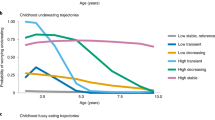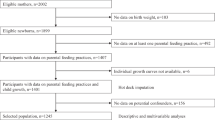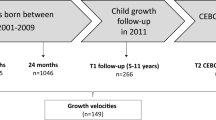Abstract
Background
Child eating behaviors are highly heterogeneous and their longitudinal impact on childhood weight is unclear. The objective of this study was to characterize eating behaviors during the first 10 years of life and evaluate associations with BMI at age 11 years.
Method
Data were parental reports of eating behaviors from 15 months to age 10 years (n = 12,048) and standardized body mass index (zBMI) at age 11 years (n = 4884) from the Avon Longitudinal Study of Parents and Children. Latent class growth analysis was used to derive latent classes of over-, under-, and fussy-eating. Linear regression models for zBMI at 11 years on each set of classes were fitted to assess associations with eating behavior trajectories.
Results
We identified four classes of overeating; “low stable” (70%), “low transient” (15%), “late increasing” (11%), and “early increasing” (6%). The “early increasing” class was associated with higher zBMI (boys: β = 0.83, 95% CI: 0.65, 1.02; girls: β = 1.1; 0.92, 1.28) compared with “low stable.” Six classes were found for undereating; “low stable” (25%), “low transient” (37%), “low decreasing” (21%), “high transient” (11%), “high decreasing” (4%), and “high stable” (2%). The latter was associated with lower zBMI (boys: β = −0.79; −1.15, −0.42; girls: β = −0.76; −1.06, −0.45). Six classes were found for fussy eating; “low stable” (23%), “low transient” (15%), “low increasing” (28%), “high decreasing” (14%), “low increasing” (13%), and “high stable” (8%). The “high stable” class was associated with lower zBMI (boys: β = −0.49; −0.68–0.30; girls: β = −0.35; −0.52, −0.18).
Conclusions
Early increasing overeating during childhood is associated with higher zBMI at age 11. High persistent levels of undereating and fussy eating are associated with lower zBMI. Longitudinal trajectories of eating behaviors may help identify children potentially at risk of adverse weight outcomes.
This is a preview of subscription content, access via your institution
Access options
Subscribe to this journal
Receive 12 print issues and online access
$259.00 per year
only $21.58 per issue
Buy this article
- Purchase on Springer Link
- Instant access to full article PDF
Prices may be subject to local taxes which are calculated during checkout



Similar content being viewed by others
References
Ashcroft J, Semmler C, Carnell S, van Jaarsveld CHM, Wardle J. Continuity and stability of eating behaviour traits in children. Eur J Clin Nutr. 2008;62:985–90.
Derks IPM, Bolhuis K, Sijbrands EJG, Gaillard R, Hillegers MHJ, Jansen PW. Predictors and patterns of eating behaviors across childhood: results from The Generation R study. Appetite. 2019;141:104295.
Farrow C, Blissett J. Stability and continuity of parentally reported child eating behaviours and feeding practices from 2 to 5 years of age. Appetite. 2012;58:151–6.
Emmett PM, Hays NP, Taylor CM. Factors associated with maternal worry about her young child exhibiting choosy feeding behaviour. Int J Environ Res Public Health. 2018;15:1236
Cardona Cano S, Tiemeier H, Van Hoeken D, Tharner A, Jaddoe VW, Hofman A, et al. Trajectories of picky eating during childhood: a general population study. Int J Eat Disord. 2015;48:570–9.
Taylor CM, Steer CD, Hays NP, Emmett PM. Growth and body composition in children who are picky eaters: a longitudinal view. Eur J Clin Nutr. 2018;73:869–78.
Braet C, Claus L, Goossens L, Moens E, Van Vlierberghe L, Soetens B. Differences in eating style between overweight and normal-weight youngsters. J Health Psychol. 2008;13:733–43.
Hajna S, LeBlanc PJ, Faught BE, Merchant AT, Cairney J, Hay J, et al. Associations between family eating behaviours and body composition measures in peri-adolescents: results from a community-based study of school-aged children. Can J Public Health. 2014;105:E15–21.
Domoff SE, Miller AL, Kaciroti N, Lumeng JC. Validation of the Children’s Eating Behaviour Questionnaire in a low-income preschool-aged sample in the United States. Appetite. 2015;95:415–20.
Jansen PW, Roza SJ, Jaddoe VW, Mackenbach JD, Raat H, Hofman A, et al. Children’s eating behavior, feeding practices of parents and weight problems in early childhood: results from the population-based Generation R Study. Int J Behav Nutr Phys Act. 2012;9:130.
Webber L, Hill C, Saxton J, Van Jaarsveld CH, Wardle J. Eating behaviour and weight in children. Int J Obes. 2009;33:21–8.
Sanchez U, Weisstaub G, Santos JL, Corvalan C, Uauy R. GOCS cohort: children's eating behavior scores and BMI. Eur J Clin Nutr. 2016;70:925–8.
Svensson V, Lundborg L, Cao Y, Nowicka P, Marcus C, Sobko T. Obesity related eating behaviour patterns in Swedish preschool children and association with age, gender, relative weight and parental weight-factorial validation of the Children’s Eating Behaviour Questionnaire. Int J Behav Nutr Phys Act. 2011;8:134.
Cao YT, Svensson V, Marcus C, Zhang J, Zhang JD, Sobko T. Eating behaviour patterns in Chinese children aged 12-18 months and association with relative weight-factorial validation of the Children’s Eating Behaviour Questionnaire. Int J Behav Nutr Phys Act. 2012;9:5.
Parkinson KN, Drewett RF, Le Couteur AS, Adamson AJ. TGMSC do maternal ratings of appetite in infants predict later Child Eating Behaviour Questionnaire scores and body mass index? Appetite. 2010;54:186–90.
van Jaarsveld CHM, Llewellyn CH, Johnson L, Wardle J. Prospective associations between appetitive traits and weight gain in infancy. Am J Clin Nutr. 2011;94:1562–7.
Steinsbekk S, Wichstrom L. Predictors of change in BMI from the age of 4 to 8. J Pediatr Psychol. 2015;40:1056–64.
Antoniou EE, Roefs A, Kremers SP, Jansen A, Gubbels JS, Sleddens EF, et al. Picky eating and child weight status development: a longitudinal study. J Hum Nutr Diet. 2016;29:298–307.
de Barse LM, Tiemeier H, Leermakers ET, Voortman T, Jaddoe VW, Edelson LR, et al. Longitudinal association between preschool fussy eating and body composition at 6 years of age: The Generation R Study. Int J Behav Nutr Phys Act. 2015;12:153.
Mallan KM, Fildes A, Magarey AM, Daniels LA. The relationship between number of fruits, vegetables, and noncore foods tried at age 14 months and food preferences, dietary intake patterns, fussy eating behavior, and weight status at age 3.7 years. J Acad Nutr Diet. 2016;116:630–7.
Carruth BR, Skinner JD. Revisiting the picky eater phenomenon: neophobic behaviors of young children. J Am Coll Nutr. 2000;19:771–80.
Boyd A, Golding J, Macleod J, Lawlor DA, Fraser A, Henderson J, et al. Cohort profile: the ‘children of the 90s’-the index offspring of the Avon Longitudinal Study of Parents and Children. Int J Epidemiol. 2013;42:111–27.
Fraser A, Macdonald-Wallis C, Tilling K, Boyd A, Golding J, Smith GD, et al. Cohort profile: The Avon Longitudinal Study of Parents and Children: ALSPAC mothers cohort. Int J Epidemiol. 2013;42:97–110.
Cole TJ, Bellizzi MC, Flegal KM, Dietz WH. Establishing a standard definition for child overweight and obesity worldwide: international survey. BMJ. 2000;320:1240–3.
Clogg C. Latent class models: recent developments and prospects for the future. In: Arminger G, Clogg C, Sobel M, editors. Handbook of statistical modeling for the social and behavioral sciences. New York, NY: Plenum Press; 1995. p. 311–59.
Berlin KS, Parra GR, Williams NA. An introduction to latent variable mixture modeling (part 2): longitudinal latent class growth analysis and growth mixture models. J Pediatr Psychol. 2014;39:188–203.
Asparouhov T, Muthen B. Auxiliary variables in mixture modeling: three-step approaches using Mplus. Struct Equ Model. 2014;21:329–41.
Goodman LA. On the assignment of individuals to latent classes. Sociol Methodol. 2007;37:1–22.
Muthen LK, Muthen B. Mplus user’s guide. 8th ed. Los Angeles, CA: Muthén & Muthén; 1997–2017.
StataCorp. Stata Statistical Software: Release 15. College Station, TX: StataCorp LLC; 2017.
Northstone K, Emmett P, Nethersole F. Pregnancy ASTALSo, childhood. The effect of age of introduction to lumpy solids on foods eaten and reported feeding difficulties at 6 and 15 months. J Hum Nutr Diet. 2001;14:43–54.
Syrad H, Llewellyn CH, Johnson L, Boniface D, Jebb SA, van Jaarsveld CHM, et al. Meal size is a critical driver of weight gain in early childhood. Sci Rep. 2016;6:28368
Huang TT, Howarth NC, Lin BH, Roberts SB, McCrory MA. Energy intake and meal portions: associations with BMI percentile in U.S. children. Obes Res. 2004;12:1875–85.
McConahy KL, Smiciklas-Wright H, Birch LL, Mitchell DC, Picciano MF. Food portions are positively related to energy intake and body weight in early childhood. J Pediatr. 2002;140:340–7.
Carnell S, Wardle J. Measuring behavioural susceptibility to obesity: validation of the child eating behaviour questionnaire. Appetite. 2007;48:104–13.
Syrad H, Johnson L, Wardle J, Llewellyn CH. Appetitive traits and food intake patterns in early life. Am J Clin Nutr. 2016;103:231–5.
van Jaarsveld CHM, Boniface D, Llewellyn CH, Wardle J. Appetite and growth A longitudinal sibling analysis. JAMA Pediatr. 2014;168:345–50.
Tharner A, Jansen PW, Kiefte-de Jong JC, Moll HA, van der Ende J, Jaddoe VW, et al. Toward an operative diagnosis of fussy/picky eating: a latent profile approach in a population-based cohort. Int J Behav Nutr Phys Act. 2014;11:14.
Locke AE, Kahali B, Berndt SI, Justice AE, Pers TH, Felix R. et al. Genetic studies of body mass index yield new insights for obesity biology. Nature. 2015;518:197
Llewellyn C, Wardle J. Behavioral susceptibility to obesity: gene-environment interplay in the development of weight. Physiol Behav. 2015;152:494–501.
Llewellyn CH, Trzaskowski M, van Jaarsveld CHM, Plomin R, Wardle J. Satiety mechanisms in genetic risk of obesity. JAMA Pediatr. 2014;168:338–44.
Konttinen H, Llewellyn C, Wardle J, Silventoinen K, Joensuu A, Mannisto S, et al. Appetitive traits as behavioural pathways in genetic susceptibility to obesity: a population-based cross-sectional study. Sci Rep. 2015;5:14726.
de Lauzon-Guillain B, Clifton EA, Day FR, Clement K, Brage S, Forouhi NG, et al. Mediation and modification of genetic susceptibility to obesity by eating behaviors. Am J Clin Nutr. 2017;106:996–1004.
Jacob R, Drapeau V, Tremblay A, Provencher V, Bouchard C, Perusse L. The role of eating behavior traits in mediating genetic susceptibility to obesity. Am J Clin Nutr. 2018;108:445–52.
Vilela S, Hetherington MM, Oliveira A, Lopes C. Tracking diet variety in childhood and its association with eating behaviours related to appetite: the generation XXI birth cohort. Appetite. 2018;123:241–8.
de Barse LM, Tiemeier H, Leermakers ETM, Voortman T, Jaddoe VWV, Edelson LR, et al. Longitudinal association between preschool fussy eating and body composition at 6 years of age: the Generation R Study. International J Behav Nutr Phys Act. 2015;12:8.
APA. Diagnostic and statistical manual of mental disorders (DSM-V). Arlington, VA: APA Press; 2013.
Bryant‐Waugh R. Avoidant restrictive food intake disorder: an illustrative case example. 1 online resource p. New York, N.Y: Wiley; 2013.
Fisher MM, Rosen DS, Ornstein RM, Mammel KA, Katzman DK, Rome ES, et al. Characteristics of avoidant/restrictive food intake disorder in children and adolescents: a “new disorder” in DSM-5. J Adolesc Health. 2014;55:49–52.
Herle M, De Stavola B, Hübel C, Abdulkadir M, Ferreira DS, Loos RJF, et al. A longitudinal study of eating behaviours in childhood and later eating disorder behaviours and diagnoses. British J Psychiatr. 2020;216:113–9.
Smith AD, Herle M, Fildes A, Cooke L, Steinsbekk S, Llewellyn CH. Food fussiness and food neophobia share a common etiology in early childhood. J Child Psychol Psyc. 2017;58:189–96.
Blissett J, Meyer C, Haycraft E. Maternal mental health and child feeding problems in a non-clinical group. Eating Behaviors. 2007;8:311–8.
Ram N, Grimm KJ. Growth mixture modeling: a method for identifying differences in longitudinal change among unobserved groups. Int J Behav Dev. 2009;33:565–76.
Bray BC, Lanza ST, Tan X. Eliminating bias in classify-analyze approaches for latent class analysis. Struct Equ Model. 2015;22:1–11.
Acknowledgements
We are extremely grateful to all the families who took part in this study, the midwives for their help in recruiting them, and the whole ALSPAC team, which includes interviewers, computer and laboratory technicians, clerical workers, research scientists, volunteers, managers, receptionists, and nurses.
Funding
This work was supported by the UK Medical Research Council and the Medical Research Foundation (ref: MR/R004803/1). The UK Medical Research Council and Wellcome (Grant ref: 102215/2/13/2) and the University of Bristol provide core support for ALSPAC. A comprehensive list of grants funding is available on the ALSPAC website (http://www.bristol.ac.uk/alspac/external/documents/grant-acknowledgements.pdf). CMB acknowledges funding from the Swedish Research Council (VR Dnr: 538–2013–8864). The funders were not involved in the design or conduct of the study; collection, management, analysis, or interpretation of the data; or preparation, review, or approval of the manuscript.
Author information
Authors and Affiliations
Contributions
MH, BDS, CMB, RB-W, and NM designed the research; MH and BDS performed statistical analyses; all authors wrote and revised the manuscript for important intellectual content; NM had primary responsibility for final content. All authors read and approved the final manuscript.
Corresponding author
Ethics declarations
Conflict of interest
CMB reports: Shire (grant recipient, Scientific Advisory Board member) and Pearson and Walker (author, royalty recipient). The other authors declare that they have no conflict of interest.
Ethical approval
Ethical approval for the study was obtained from the ALSPAC Ethics and Law Committee and the Local Research Ethics Committees. All procedures were performed in accordance with the ethical standards laid down in the 1964 Declaration of Helsinki and its later amendments.
Additional information
Publisher’s note Springer Nature remains neutral with regard to jurisdictional claims in published maps and institutional affiliations.
Supplementary information
Rights and permissions
About this article
Cite this article
Herle, M., Stavola, B.D., Hübel, C. et al. Eating behavior trajectories in the first 10 years of life and their relationship with BMI. Int J Obes 44, 1766–1775 (2020). https://doi.org/10.1038/s41366-020-0581-z
Received:
Revised:
Accepted:
Published:
Issue Date:
DOI: https://doi.org/10.1038/s41366-020-0581-z
This article is cited by
-
Stability of child appetitive traits and association with diet quality at 5 years and 9–11 years old: Findings from the ROLO longitudinal birth cohort study
European Journal of Clinical Nutrition (2024)
-
Childhood hyperactivity, eating behaviours, and executive functions: Their association with the development of eating-disorder symptoms in adolescence
Journal of Eating Disorders (2023)
-
Characteristics of eating behavior profiles among preschoolers with low-income backgrounds: a person-centered analysis
International Journal of Behavioral Nutrition and Physical Activity (2022)
-
Ecological factors and childhood eating behaviours at 5 years of age: findings from the ROLO longitudinal birth cohort study
BMC Pediatrics (2022)
-
The longitudinal association of eating behaviour and ADHD symptoms in school age children: a follow-up study in the RHEA cohort
European Child & Adolescent Psychiatry (2022)



